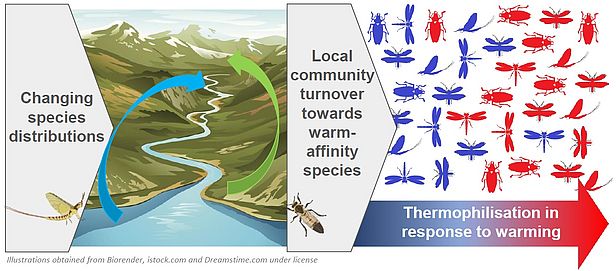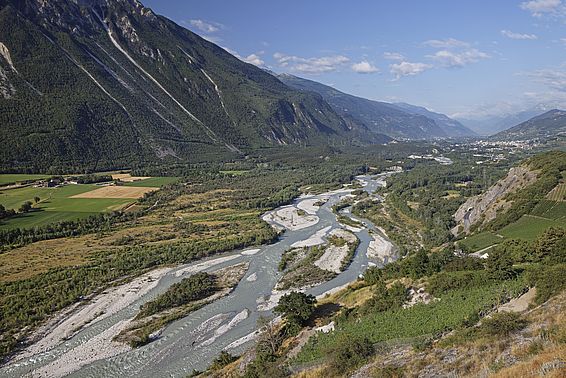Ecological communities in rivers and lakes are responding to climate change in a similar way to communities on land. This is shown by the first comprehensive comparison of freshwater and terrestrial ecosystems around the globe, co-led by Eawag and WSL. When temperatures rise, warm-loving species are the main beneficiaries. One surprising exception may be the plankton.
As it gets warmer, many species are forced to leave their established habitats, moving northwards or upwards in elevation in search of cooler climates. Locally, cold-adapted species may be lost, displaced by warm-loving species. Over time, warm-loving species become more prevalent, and researchers refer to this turnover as thermophilisation.
“Globally, we already have a relatively good understanding of how, and how quickly, ecological communities in terrestrial and marine environments are responding to climate change,” explains Anita Narwani, head of the Algal Biodiversity and Ecosystem Functioning group at the aquatic research institute Eawag. “However, how freshwater communities are responding to warming compared to terrestrial ones had not been systematically investigated or compared.” But, the habitats in lakes and rivers are of particular interest. Their species richness is disproportionately high compared to both terrestrial and marine ecosystems per unit area of habitat, and at the same time, the rate of species decline is particularly dramatic. Freshwater ecosystems are also among the most sensitive habitats to human impacts, possibly due distinct spatial boundaries, limiting the potential for species to escape via dispersal.

Comparison of responses in freshwater and on land
As part of the Blue-Green Biodiversity BGB research initiative, an international team of scientists led by Anita Narwani and Christian Rixen from the WSL Institute for Snow and Avalanche Research SLF has now analysed the species communities in freshwater and terrestrial systems for the first time in a systematic, global study. They used all the data available worldwide, totalling 13,324 data sets, including 6,201 terrestrial communities with plants, birds, insects and mammals and 7,123 aquatic communities with fish, insects, phytoplankton and zooplankton. The data covers a total of 17,431 species and periods of 5 to 38 years between 1980 and 2019. “As we only have little data from the tropical and polar regions, however, our main conclusions are limited to the temperate latitudes,” Anita Narwani qualifies.
“We have found that there are no significant differences between freshwater and terrestrial ecosystems in the overall rate of thermophilisation. So we observe the same pattern in freshwater as on land: a trend towards a greater prevalence of warm-loving species, while species adapted to the cold become rarer,” summarises Imran Khaliq, lead author of the study, which was published recently in the journal Nature Communications. He carried out the analyses as a postdoctoral researcher in Anita Narwani's team. “However, the rate of thermophilisation in response to temperature change differs. On land, the species composition has changed faster," says Imran Khaliq. “This difference may be attributed to the slower warming experienced within the freshwater realm, which puts less pressure on the aquatic communities to respond.”
The surprise: cold-loving plankton are doing alright
Plankton communities are an exception; they are responding differently than expected. Here, analyses suggest that cold-loving species may benefit from climate change. “That surprised us,” says Imran Khaliq. “And the reasons for this are not really understood at the moment.” A simple explanation would be that cold-loving species used to live in regions with temperatures below their optimal, or preferred, temperature. This phenomenon has already been documented for marine systems. Warming would therefore initially be good for them before the rise in temperature becomes so strong that the cold-loving species come under pressure and ultimately disperse away or die out. This is also supported by the fact that lakes and rivers have warmed less quickly than habitats on land.
Another explanation could be that cold-loving species are well adapted to other environmental changes such as nutrient availability. The observed increase in cold-loving plankton species could therefore also be due to a reason other than global warming. “However, we cannot test these hypotheses with the available data”, explains Anita Narwani. She is already busy planning another research project to characterise the spatial distribution of species in 240 Swiss lakes in order to find an explanation for this surprising observation.
High biodiversity - high resilience
“Another interesting result was that in terrestrial ecosystems, a high species richness makes the communities less sensitive to climate change,” adds Anita Narwani. “Species-rich communities on land therefore respond more slowly to rising temperatures than species-poor communities.” This does not mean that these communities will not come under stress at some point. It may just take longer. “There may also be an extinction debt; when there is a delay between the cause, in this case climate change, and the final disappearance of a species. And this final disappearance can then happen very quickly.” Although the researchers have observed a similar trend in freshwater, i.e. greater resilience in more species-rich communities, it is much less pronounced and not significant.
The results of the study and the comparison of aquatic and terrestrial ecosystems help to understand how ecological communities are reacting to climate change and where differences in their responses come from. “Knowing the reasons is key to developing better strategies for the protection and management of ecosystems and identifying those species that are particularly vulnerable to local extinctions,” summarises Anita Narwani.
Research initiative Blue-Green Biodiversity
The research project “Warming-related community turnover in terrestrial and freshwater ecosystems" contributes to the Blue-Green Biodiversity research initiative - an Eawag-WSL collaboration addressing biodiversity at the interface of aquatic and terrestrial ecosystems. The initiative is funded by the ETH Board.
Contacts
Publications
Khaliq, I., Rixen, C., Zellweger, F., Graham, C. H., Gossner, M. M., McFadden, I. R., … Narwani, A. (2024). Warming underpins community turnover in temperate freshwater and terrestrial communities. Nature Communications, 15, 1921 (9 pp.). https://doi.org/10.1038/s41467-024-46282-z
McFadden, I. R., Sendek, A., Brosse, M., Bach, P. M., Baity‐Jesi, M., Bolliger, J., … Narwani, A. (2023). Linking human impacts to community processes in terrestrial and freshwater ecosystems. Ecology Letters, 26(2), 203-218. https://doi.org/10.1111/ele.14153
Copyright
WSL and SLF provide image and sound material free of charge for use in the context of press contributions in connection with this media release. The transfer of this material to image, sound and/or video databases and the sale of the material by third parties are not permitted.
